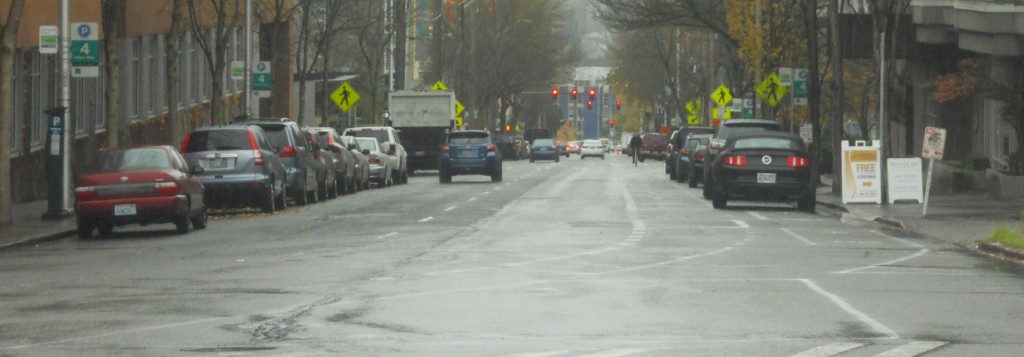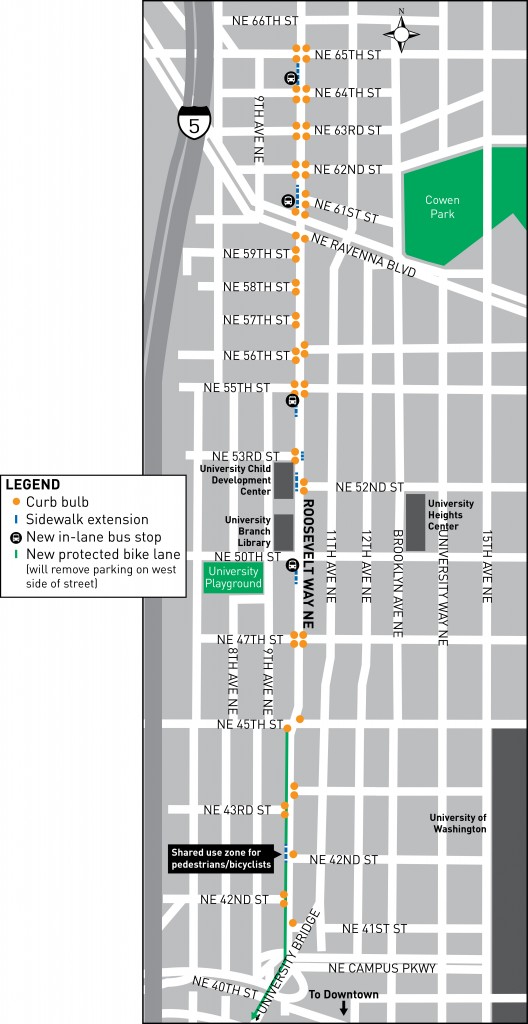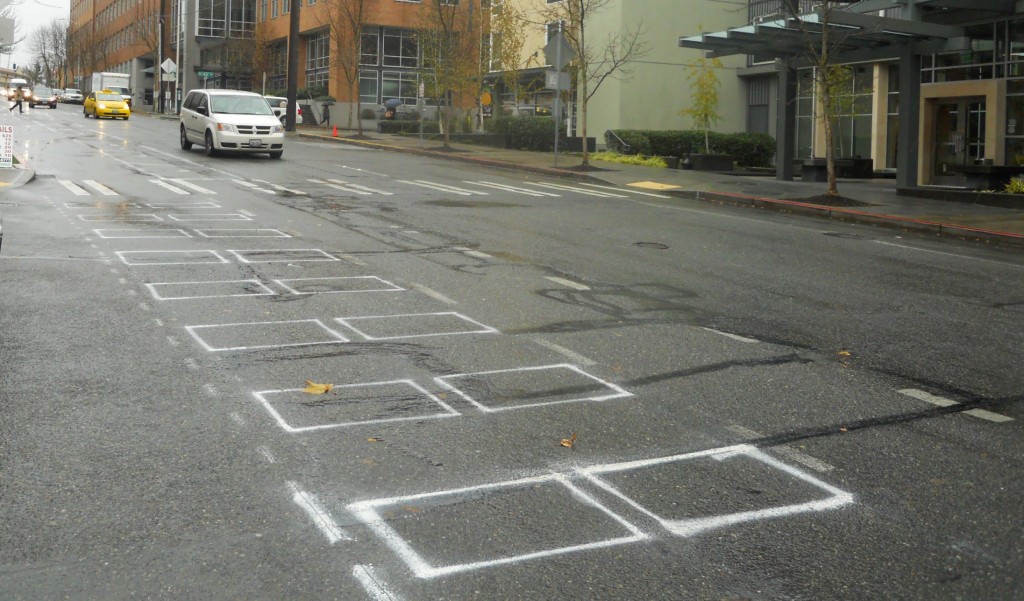
The Seattle Department of Transportation (SDOT) expects to repave arterial streets every ten to twelve years, and each cycle presents an opportunity to comply with the City’s Complete Streets ordinance and improve mobility for all users. One such project is due to be completed next summer in northeast Seattle. The repaving of Roosevelt Way between NE 65th Street and NE 40th Street will include the replacement of a parking lane with a protected bike lane in the area south of NE 45th Street. In an unprecedented move, a temporary version of the protected bike lane will be constructed within the next two months before the full repaving next year. This may hint at the growing influence of active residents and a change in the City’s responsiveness to safety concerns.
Roosevelt Way is a one-way southbound street with two drive lanes, two  parking lanes, and a painted bike lane. The street carries bus routes and the speed limit is 30 mph. Roosevelt is one of the most dangerous streets for cyclists in the entire city; between 2007 and 2014, the street has seen at least 63 bike-car collisions. But Roosevelt Way is popular with bicyclists because it is the fastest and most direct route to Downtown via the University Bridge, which is one of only two Ship Canal crossings in the area.
parking lanes, and a painted bike lane. The street carries bus routes and the speed limit is 30 mph. Roosevelt is one of the most dangerous streets for cyclists in the entire city; between 2007 and 2014, the street has seen at least 63 bike-car collisions. But Roosevelt Way is popular with bicyclists because it is the fastest and most direct route to Downtown via the University Bridge, which is one of only two Ship Canal crossings in the area.
University Greenways, a neighborhood group that advocates on bike and walking safety, examined the 30 percent design drawings (PDF) last month. (Disclosure: I am a volunteer with the group.) At that point, the project did not include a protected bike lane at all, despite the City’s Bicycle Master Plan designating the route for a buffered facility. The group also conducted a walking audit of the project area. In a letter to SDOT (PDF) and a guest post on Seattle Bike Blog, they highlighted a laundry list of problems that the City should focus on, and some of those are being addressed. Many new curb ramps and sidewalk bulbouts will be built at intersections to comply with ADA guidelines and to reduce crossing distances.
In a surprising response, the 60 percent design drawings (PDF) released this month shows SDOT will remove the right-side parking lane south of NE 45th Street (where the most bike-car collisions have been) and replace it with a 7-foot bike lane and 5-foot buffer with plastic, reflective bollards. Similar to the rapid construction of Downtown’s 2nd Avenue cycle track in September, SDOT is going above and beyond by creating this lane almost immediately instead of waiting until the full repaving next year. This is a great victory for bicyclists both in the neighborhood and citywide, and illustrates how grassroots efforts can influence the outcome of multi-million dollar projects. Other neighborhood groups should be encouraged to speak out for bike and walking infrastructure so that people of all ages and abilities can move about safely and efficiently.
More still needs to be done, though. The protected bike lane conflicts with a loading area for a busy medical clinic and ends at a critical junction before the University Bridge where cars and buses merge. Roosevelt’s sister street, the northbound 11th/12th Avenue, has the same configuration and is also planned to have a protected bike lane, but it is not being repaved at this time. Funding for full sidewalk repairs has not been secured for the Roosevelt project area. Money is also being sought for additional bulbouts at bus stops, which allow buses to stop in-lane and waste no time by pulling back into traffic. At an open house last Tuesday, one staff member expressed confidence that the money can be found in time. The project is currently being funded by the 2006 Bridging the Gap levy and federal money.
Roosevelt’s protected bike lane should also be extended northward as far as possible, or at least to NE 65th Street. Participants at the meeting had understandable concerns about the loss of parallel parking and loading zones for businesses and apartment buildings. This is a common issue that is brought up with any removal of parking anywhere, of course, but there is a possible compromise. Many of Seattle’s multi-lane arterial streets allow parking in the curb lane, except during peak hours of 7-9 AM and/or 4-6 PM. During those hours the parking lane becomes a drive lane. This system could be applied to Roosevelt, so the right-side drive lane would become a parking lane or loading zone during off-peak hours.

SDOT will have the chance to test this idea next summer when the repaving process will necessitate the closure of one drive lane during off-peak hours. Myself and others at the meeting urged staffers to do traffic counts to test the feasibility of this idea, and they were receptive. The street only carries about 11,000 vehicles per day, which is well within the threshold for a road diet (PDF).
The City shouldn’t need to be pushed to comply with its own plans, but oftentimes it’s necessary. Persistent, polite, and knowledgeable input from local residents and businesses is needed to ensure Seattle’s streets transform into the multi-modal network everyone needs.
Scott Bonjukian is a graduate student at the University of Washington’s Department of Urban Design and Planning. He writes about local and regional planning issues at his personal blog, The Northwest Urbanist.
Scott Bonjukian has degrees in architecture and planning, and his many interests include neighborhood design, public space and streets, transit systems, pedestrian and bicycle planning, local politics, and natural resource protection. He cross-posts from The Northwest Urbanist and leads the Seattle Lid I-5 effort. He served on The Urbanist board from 2015 to 2018.



